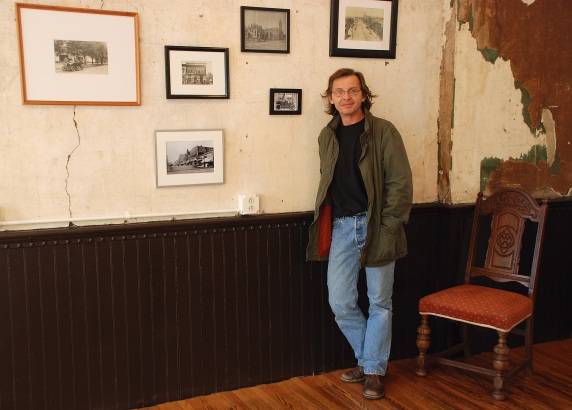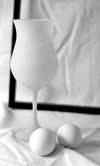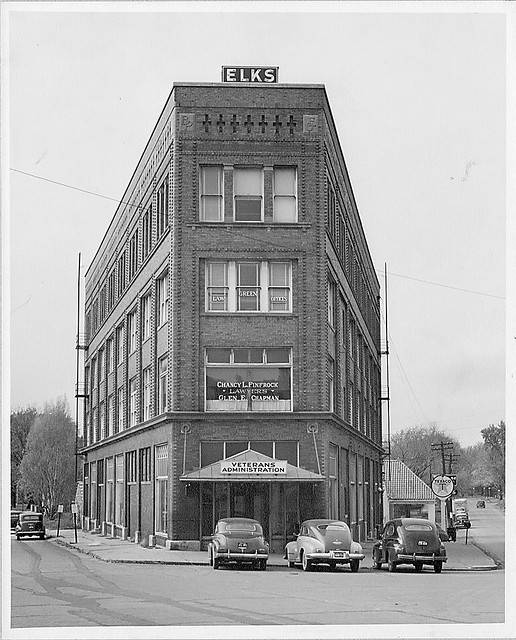
Photo by Lyosha Svinarski
Roughly four months after its opening, according to its curator Lyosha Svinarski, the Urbana Museum of Photography is off to a good start. The museum, at 122A West Main in downtown Urbana — on the second floor next to the Cinema Art Gallery — is mostly for traditional and silver-print photography, with an emphasis on local subjects and history. Essentially, it’s a vehicle for Svinarski to look at this community’s traditions (from the 1800s until now) through a traditional medium (pre-digital photography). The museum is open to the public on Thursdays and Fridays between 2:00–6:00 p.m., and on Saturdays from 11:00 a.m.–2:00 p.m.
According to Svinarski, the museum will one day serve as a type of salon for community photographers and enthusiasts to gather and discuss the art of photography, as they did at photography studios during the early days of the medium. “Back then, there was no digital — everyone had to go to the studios,” he said.
 The museum has wall space for various photographs, temporary exhibitions, shows, and Svinarski hopes to soon offer classes on photography, art, and darkroom skills (there’s a darkroom in the museum). Svinarksi said about two to six people have been coming each day the museum has been open, which gives him the opportunity to talk at length with visitors, something he clearly enjoys doing; he spoke with me for about an hour on a recent Saturday afternoon with great enthusiasm about what the museum is about and how he wants it to grow.
The museum has wall space for various photographs, temporary exhibitions, shows, and Svinarski hopes to soon offer classes on photography, art, and darkroom skills (there’s a darkroom in the museum). Svinarksi said about two to six people have been coming each day the museum has been open, which gives him the opportunity to talk at length with visitors, something he clearly enjoys doing; he spoke with me for about an hour on a recent Saturday afternoon with great enthusiasm about what the museum is about and how he wants it to grow.
Traditional Photography
 Svinarski used one of his own pictures (right), “Composition in White,” a still life that is displayed on the wall of the museum, to explain his philosophy of the art and craft of photography:
Svinarski used one of his own pictures (right), “Composition in White,” a still life that is displayed on the wall of the museum, to explain his philosophy of the art and craft of photography:
This particular picture reflects my style and approach to photography, which is simplicity and purity. I really like to emphasize the subject matter of still life. I think it’s challenging to make a still life composition work. Also, space within the composition is very, very important because that’s what brings the subject matter to the meaningful volume. I’m creating geometrical forms and other structures – space within the space — that will not overwhelm the image, but bring something more into it.
I’m kind of an old-timer, and I like to go back to the traditional photography. My approach is from years of doing paintings — I’ve been painting for 25 years. I see photography as a pictorial form, because that’s where photography came from in the 1800s. Photographers were in competition with the portraiture and the landscape painters. People would pay so much money to have someone paint or to have someone take a picture. Back then, with the advance of science — chemistry and physics — the development of films, of glass plate photography and other things, there were so many changes. So here we go — we have a combination of science and aesthetics that created the art of photography.
Today, everyone shoots digital images of course, and we kind of lose that sense of what photography is all about, what it’s supposed to be — is it art or is it simply documenting subjects or moments? Ten years ago, we were still having the discussion of which type of image is better, digital or traditional. Today, the general public has been spoiled with digital photography because it’s just point and shoot the camera and you don’t have to be a photographer to take good pictures. Then it goes to Facebook or whatever and we call that publishing. It is photography, but it’s not what it once was — you can play with a digital image; you can torture it, transforming it to something else, far from the original scene. Back then, photography not only was about taking pictures, it was about making a photograph. It taught you how to be in the world. How to communicate with people. You had to learn that skill — how to be communicative with your subject matter, with nature. It was a social skill as well.
Kids today, they learn how to type before handwriting. And that’s good, in a way; that’s progress, but I’d like to keep tradition alive. If you apply that to any art — music, dance, architecture — you will be a better improviser if you would know the basics.
Historical Urbana
Some of the pictures on the wall of the museum are on loan from the Champaign County Historical Archives nearby at the Urbana Free Library. One is of the Flat Iron Building in Urbana, which burned down in 1948 and stood about where Strawberry Fields is now. Svinarski recalled an older man who saw the picture on the wall of the museum and began talking about the memories it brought back: “The gentleman was about 90 years old. He barely made it up here. I pulled up a chair. He saw this photograph and started telling me all these old stories about his family. He started crying.”

Photograph courtesy of UI Urbana Library Digital Collection
Svinarski mentioned that he is trying to find all the old photographs he can of Abraham Lincoln — a man who liked to have his picture taken. He’s also searching for any photographs of Urbana in the 1800s and 1900s that he can find, and said he’s been researching the area through images for years:
I’ve seen the old photographs of all the lawyers’ offices in Urbana. The offices extended all the way to the north from Main Street to the railroad tracks before the fire of 1871. It’s incredible.
I found out how much interest there was in traditional photography of historic Urbana, and then I started exploring the archives and I just freaked out. For example, you know Chief Illini, of course — did you know there was a Princess Illini as well? One has to see the pictures.
From Russia to Urbana
Though he’s very interested in the history of Champaign County, Svinarski said that he isn’t from here:
I’m from St. Petersburg, Russia. I came here in 1989. I’m a pediatrician by education. I came over here with tendencies to continue my medical career. I volunteered here in several places, and what I found out is that the system here is totally different from what I knew and it’s completely insane — I call it ‘the Bermuda Triangle Hospital.’ Between the hospital and the insurance companies and the pharmaceutical companies, the patient gets lost without a trace and there was nothing that I could do about it. It made me very grumpy and who needs a grumpy doctor?
While medicine may not have worked out for him in the States, he said he could still put to use his passion for artistic expression:
Back in St. Petersburg, my wife and all my friends were artists. So I made up my mind when I was 32, 33 years old — it was 1990 — that I wanted to work here in art. I worked in photography, in painting, and I built pipe organs – a lot of different things. But they all had to do with the creative process. I wasn’t working in a factory or whatever – it was art. Different mediums, but the same field.
Getting the money for a future of looking back
Although the museum sells photographs, books, and postcards of Urbana, Svinarksi said that he can’t rely on money from sales: “I’ve seen situations in galleries where there are financial problems and then someone walks in and writes a huge check for something, but you can’t depend on that.”
For now, the City of Urbana’s Gallery District Incentive Program is paying half of the rent for the museum. Moreover, he’s working with Laura Huth at do good Consulting as he looks towards turning the museum into a nonprofit. He’s also using his own money, earned as a freelance photographer, to sell his work for private and public displays.
He said he’s been providing most of the labor for the museum himself, but that he does have a volunteer who puts in hours as well. As for where it’s all at right now, Svinarski elaborated:
I think the community is very happy with the museum so far. I’ve had excellent feedback. I’ve gotten some donations and people are bringing in pictures. A woman brought in her old family pictures the other day. It tells me how important history is. It is crucial to know where we came from and how different we are, to have a reference that makes all of us who we are today. Art is a history — it is made by artists of particular times, and in the case of photography, it is the Art of Time.








